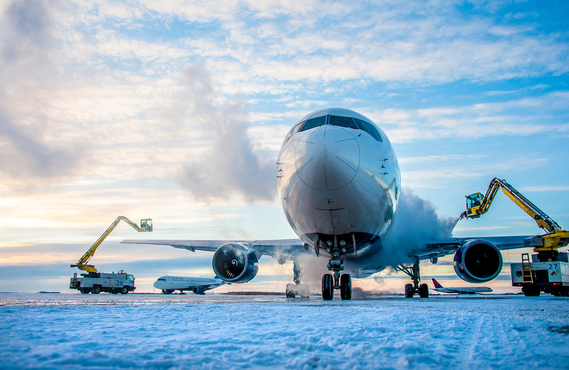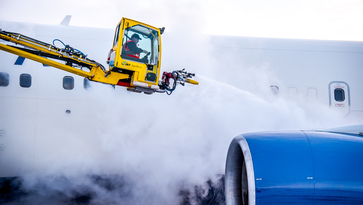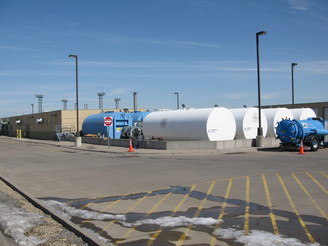|
Each winter when aircraft deicing operations begin at Minneapolis-St. Paul International Airport, the work is guided by field rules from the Metropolitan Airports Commission (MAC), which has invested more than $150 million in deicing fluid and storm water management systems.
That infrastructure enables the recovery and recycling of the fluid, which is part of MSP's ongoing commitment to environmental stewardship and sustainable practices.
The deicing work itself, easily viewed by airline passengers as they’re waiting to depart, is done by the airlines and deicing contractors.

An early start each fall
Delta Air Lines’ hub at MSP is one of the airline’s largest deicing operations in the U.S., with a fleet of almost 30 vehicles and more than 200 ramp agents. MSP saw more than 16,600 take-offs in December, 2016, and the ramp agents’ deicing work keeps those flights safe and on schedule.
In the summer months, Delta hosts extensive training programs for workers who apply the deicing fluids.
In autumn, when temperatures dip below 50 degrees, that triggers morning inspections of aircraft to look for frost and ice. Deicing fluid is made up of varying concentrations of water and propylene glycol depending on weather conditions.
 The liquid is heated and applied to the planes under high pressure.
At about the same time each autumn, the MAC begins making arrangements to prepare various airfield locations for containment of deicing fluid.
Deicing pads located throughout the airfield have specially designed drainage systems that capture the deicing fluid that's sprayed on aircraft. The recovered deicing fluid is transferred to MSP’s glycol management facility near the southwest corner of the airport.
The airlines also have the flexibility to perform deicing activities in designated spaces near the terminal gates. MSP’s infrastructure accommodates the containment of deicing fluid for the full winter season.
|
 What happens to the used deicing fluid?
Used deicing fluid is recycled and has uses in other commercial and consumer applications, and that creates an after-market for the recaptured fluid that’s collected at MSP.
Pictured: MSP's glycol management facility.
Propylene glycol is a common additive in certain foods, including frozen dairy desserts and baked goods, where it’s used as a thickener and flavor enhancer. It’s also used in small amounts in cosmetics to prevent the products from melting in warm weather or freezing in the cold.
The fluid also is used in commercial products such as antifreeze, paint, enamels and varnishes.
MSP has the capacity to store approximately 9 million gallons of recovered deicing fluid and storm water/melt water that's recovered with it at the glycol management facility.
The material recovered undergoes a recycling process operated by a contractor on behalf of the airlines, producing a product that can be marketed to firms that use propylene glycol in commercial applications.
The de-icing fluid management building, the airfield drainage system and the holding ponds that manage storm water runoff are all part of the MAC’s commitment to protecting the environment.
More information about deicing fluid management and deicing pads can be found on the MAC's sustainability dashboard, located here.
|
 When the Metropolitan Airports Commission (MAC) board chambers recently had new carpet installed, a telecoil system was laid down first to assist hearing aid users.
The telecoil, commonly called a t-coil, is connected to the public address system in the Commission chambers and will emit a magnetic signal that can be picked up with a t-coil-equipped hearing aid.
Pictured: The t-coil installed in the floor of the MAC board chambers.
The system should be in operation by early March.
When originally developed, t-coils were used to boost magnetic signals from telephone handsets in the pre-cell phone era.
In the United States today, more than 70 percent of hearing aids and all new cochlear implants are equipped with a t-coil, allowing users better sound reception in areas that use the equipment to transmit a signal.
At MSP, t-coils are being installed in public areas whenever they’re constructed or remodeled, said Alan Howell, the MAC’s senior airport architect.
The new gates that opened recently at Terminal 2-Humphrey, the short film space on Concourse C, and the international arrivals area in Terminal 1 are all equipped with t-coils.
When the renovation work along the front of Terminal 1-Lindbergh is complete, that area will have a t-coil system as well.
|
|